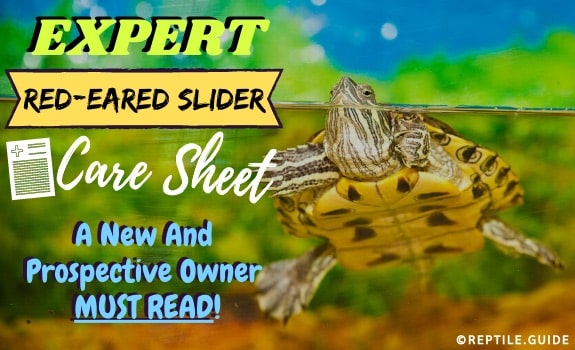Have you ever been captivated by the adorable little red-eared sliders in the pet store?
Their curious eyes, their hilarious willingness to try to eat ANYTHING that will fit into their mouths, and the graceful way that they swim around their enclosure lure many pet store goers into the world of turtle ownership.
However, unbeknownst to MOST people, caring for a red-eared slider turtle – or any turtle – requires quite a bit of foresight and planning.
The great news? You’ve ALREADY made a step in the right direction if you’re here!
Regardless of whether you’ve already brought your new friend home OR are preparing beforehand, our comprehensive red-eared slider turtle or Trachemys scripta elegans (opens in new tab) care guide will give you all of the information you need.
What You’ll Learn In This Red Eared Slider Care Sheet:
- Background information on Red Eared Sliders
- Proper diet breakdown
- How often to feed at any age
- How to properly set up a red-eared slider enclosure
- Health concerns to be aware of (plus how to prevent them!)
- Handling & bonding tips
- & So much more!
From the appropriately varied diet to the large enclosure requirements, from common ailments to useful accessories, we’ll touch base on EVERYTHING you need to know to start taking great care of your new or future pet!
SO, if you’re looking to acquire a comprehensive understanding of exactly how to best care for a Red Eared Slider, just keep reading!
In This Article
Red-Eared Slider Turtle Background Information
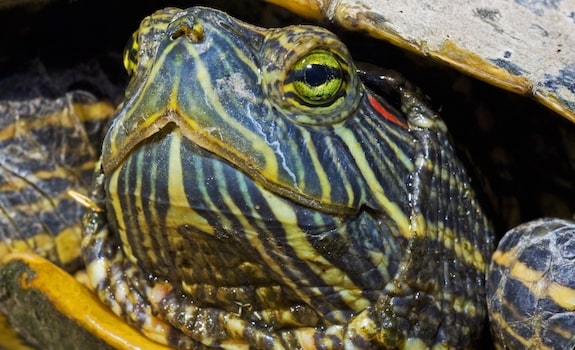
Owning a turtle, such as a red-eared slider, can be a fun and rewarding experience. Many seasoned owners thoroughly enjoy the bond and level of interaction that they achieve with their pet turtle.
In the wild, researches believe red-Eared slider turtles can live up to 50 years, however, this number is much lower for pets. You can expect a well-cared for red-eared slider to live twenty to forty years.
Their striking yellow and red markings make for an attractive aquarium or pond inhabitant in your home.
Looks wise, the red-eared slider closely resembles its cousin turtle species, the yellow-bellied slider. The primary differences in appearance are that of the red-eared slider’s red mark by its ear and lack of spotting on its plastron (belly shell).
Although they’re, like all turtles, shy in the beginning, most red-eared sliders grow to become quite personable. They will happily greet you when you enter the room.
However, unlike with more affectionate pets, you WON’T have to worry about emotionally neglecting your pet turtle…
You can develop as close or as distant of a bond as you desire, as quickly or as slowly as your schedule allows.
Being so widespread, they’re NOT a particularly fragile species. They can withstand a variety of temperatures and living conditions, at least in the short term.
However, like all ectothermic pets, there are still ideal habitat parameters that will ensure that your pet thrives.
Thanks to their adaptability, red-eared sliders are among the easiest species of turtle to care for in captivity. However, their environmental needs are a little more elaborate than a terrestrial tortoise.
Overall, compared to other reptiles, their care level can be considered intermediate. They make a decent first pet turtle for someone willing to invest the time and money required to provide the proper care.
Unlike some tortoises and even other turtles, which can grow to weigh over one-hundred pounds and reach almost two feet in length, red-eared sliders stay comparatively small. Among the aquatic turtle species commonly kept as pets, red-eared sliders can be considered average to large.
Rest assured, there ARE better options if you don’t have room for a huge aquarium.
Hatchling red-eared sliders are slightly larger than a quarter, while adults average between five and nine inches. Exceptional females may even reach up to twelve to thirteen inches!
Because of their considerable size and enclosure requirements, the average cost of owning a red-eared slider is MORE than you might expect to pay to care for a snake or even a beginner-friendly lizard.
An adequately large aquarium or pond, decorations, lighting, heating, filtration, and a basking spot will easily cost into the hundreds of dollars – at a minimum.
They also need a varied diet of plant matter and protein and aquarium additives to make their water safe.
🔑 Red-Eared Slider Background Key Takeaways: Red-Eared Slider Turtles make fabulous pets due to being fairly easy to care for and possessing a long lifespan of typically between 20 and 40 years. Although more expensive than most snakes and lizards, these turtles can be fairly affordable once their husbandry is set up. New owners should also expect initial shyness along with high tank set up costs. Red-Eared Sliders are considered average to large in size amongst aquatic turtles.
Red-Eared Slider Turtle Diet & Feeding
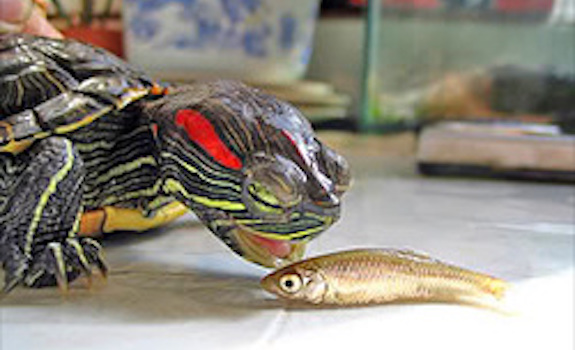
Turtle owners report spending between $20 to $50 per month to feed one red-eared slider.
This price can be broken down between pellets, vitamin and mineral supplements, freeze-dried treats, fresh fruits, vegetables, and aquatic plants, and live prey.
Some items can be purchased in bulk to last for months, while other parts of their diet need to be fresh and replenished weekly or several times a week.
What A Red-Eared Slider’s Diet Consists of
PELLETS
Pellets are a convenient part of a red-eared slider’s diet that you can purchase in bulk. They’re also an excellent way to ensure that your slider gets a variety of vitamins and minerals.
However, just like you and me, turtles are healthier when they eat a varied diet…
Try to limit pellets to 25% to 50% of your pet’s total intake. It’s also a good idea to freeze commercial pellets that your turtle won’t eat within the next three to four weeks.
FEEDERS (Animal-Based Protein)
Live prey items are an ESSENTIAL source of protein, enrichment, and exercise for your pet. Red-eared sliders seem to prefer this food group the MOST!
The sky is pretty much the limit in this department – if you can find it in a pet store for the purposes of feeding any type of pet, your turtle can probably eat it. You can also opt to purchase live, canned, or freeze-dried feeders.
This category should account for 25% or less of your turtle’s diet.
Here are some ideas…
- Invertebrates: Mealworms, crickets, earthworms, waxworms, super worms, tubifex worms, black soldier fly larvae, roaches, silkworms, aquatic snails, bloodworms, daphnia, shrimp, krill.
- Aquatic Vertebrates: Goldfish, minnows, rosy reds, guppies, tadpoles
- Rodents: Pinkie and fuzzy mice
- Grocery: Boiled beef heart, tilapia filet, lean beef, shrimp, chicken
VEGETATION (Plant Foods)
Your red-eared slider will NEED to eat his greens if he wants to be healthy and robust – like Popeye with his spinach!
Most of the plant portion of your turtle’s diet should consist of floating vegetables. This allows you to leave food in your pet’s aquarium that they can nibble on throughout the day WITHOUT spoiling the water.
Plant matter should make up around 50%, or more, of your slider’s diet.
Here are some ideas of excellent veggies to feed…
- Vegetables: Romain lettuce, collard greens, mustard greens, carrot tops, endives, Swiss chard, kale, bok choy, parsley, green beans, dandelion greens, turnip greens, clover, carrot, squash, sweet potatoes, broccoli. Avoid head lettuce due to its lack of nutritional value.
- Aquatic Plants: Anachris, water hyacinth, water lettuce, water lilies, elodia, duckweed
- Fruits: Apples, melons, mangoes, figs, strawberries, bananas, grapes, tomatoes, plums, peaches, nectarines. Remove the pits, cores, and seeds.
VITAMINS & SUPPLEMENTS
It’s not necessarily required, but is certainly beneficial and offers peace of mind to feed a powdered vitamin and mineral supplement to your turtle twice a week.
The more varied your turtle’s diet is, the BETTER, but the supplement acts as a good back up.
You can also keep a calcium block or cuttlebone in your slider’s enclosure – he or she may nibble on it for an extra calcium boost.
How Diet Varies Based on Age
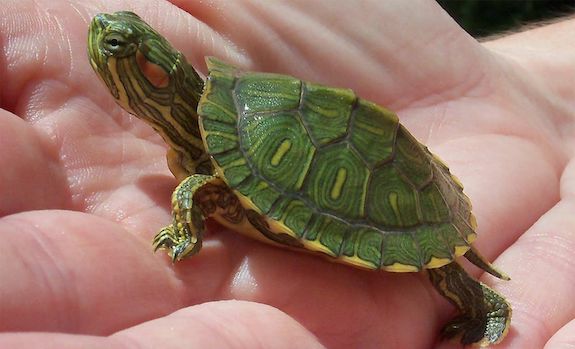
Younger red-eared sliders that are still growing require more protein than fully-matured adults.
A hatchling’s diet should consist of about 75-95% animal proteins, 5-25% pellets, and 0-5% plant matter.
Once your slider reaches six months of age, you can replace most of the protein-rich feeders with plant matter to achieve ratios of around ≥50% plant matter, ≤25% pellets, and ≤25% prey items.
At this point, you should ALSO be wary of how much you feed your turtle. They’re eager eaters, and obesity is a common issue.
Feed your pet what it can eat in five to fifteen minutes OR an amount that appears equivalent to your slider’s head size.
Feeding Schedule: How Often to Feed Them
You’ll come to find that red-eared sliders, especially those a year and older, are very low maintenance when it comes to feeding.
In fact, they make a PEFECT pet for those who fancy weekend getaways and don’t want to neglect their pet in the process.
Baby Red-Eared Sliders Feeding Schedule
Hatchling red-eared sliders that are under six months old should be fed once a day.
Adult Red-Eared Sliders Feeding Schedule
At six months of age, you can begin feeding your red-eared slider every other day. After its first birthday, you can cut back to three feedings a week.
🔑 Red-Eared Slider Diet & Feeding Key Takeaways: Like humans, a Red-Eared Slider will thrive on a varied diet that consists of pellets, feeders, vegetation, and ideally supplements and vitamins. Owners report on average spending of about $30 a month to feed a turtle. Babies under 6 months will need to eat daily while those 6 months and older can eat every other day up until a year, at which point, meals can go down to 3 times a week.
Red-Eared Slider Turtle Habitat & Tank Setup
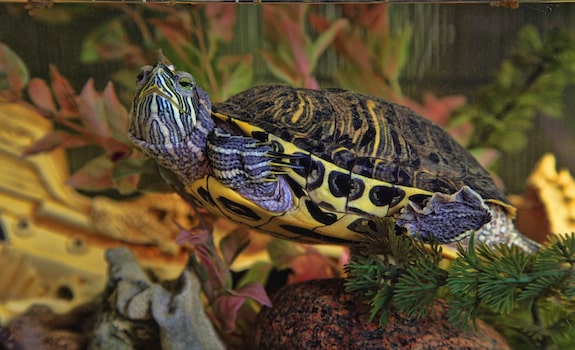
Your red-eared slider’s enclosure will account for the most significant cost of turtle ownership. Its final, adult habitat will end up being rather large, so make sure that you have the space for it – either inside or outside.
Size of the Enclosure
The general rule of thumb is to provide a red-eared slider with ten gallons of water for every inch of length, minimum.
This means that a hatchling slider can start in a twenty-gallon aquarium. Still, an adult will require at least a sixty-gallon aquarium up to maybe even a one-hundred-and-twenty-gallon aquarium.
Again, these are minimums. Red-eared sliders are VERY active turtles that enjoy swimming around all day – they will utilize (and appreciate!) any extra space that you give them.
Types of Enclosure
Red-eared sliders can live in a glass or acrylic aquarium, plastic indoor or outdoor ponds, fiberglass kiddie pools, metal stock tanks, and even wooden homemade enclosures.
Glass and acrylic aquariums are readily available, and there are manufactured lids and stands to accommodate them. They also offer optimal viewing of your pet turtle.
The other options tend to be cheaper and might even offer more space to your turtle, but they can make it challenging to observe your pet.
Wooden and metal enclosures NEED to be fitted with a pond liner to hold water without leaching chemicals.
Ideal Temperatures and Lighting
Your red-eared slider’s enclosure will require supplemental heating if you are keeping it inside. Even if you house the turtle outside, additional heating should be installed if you encounter an exceptionally chilly day.
Maintain the water temperature between 76°F and 84°F. The temperature of the basking spot should be 82°F to 88°F during the day. The nighttime temperature can fall to as low as 66°F. Always monitor the temperatures with thermometers.
If your room or the outdoor temperature is consistently above 75°F, a UVB light setup will provide sufficient heat. If your home is generally on the cooler side, you should install a submersible aquarium water heater.
A UVB light set up is essential, not only for supplemental heat, but also for your slider to bask, dry himself, and synthesize Vitamin D3.
ALWAYS set up a new enclosure with heat sources and thermometers several days before allowing your red-eared slider to live in it. This gives you ample time to calibrate your heat sources accordingly and make any changes necessary.
Once you have achieved the proper temperatures for a minimum of twenty-four hours, you can move your pet to its new habitat!
Ideal Substrate
The safest, cleanest, most economical substrate for red-eared sliders is NONE at all! This is referred to as a “bare bottom” aquarium. This setup makes food and waste clean up super simple, despite how messy red-eared sliders can be.
However, bare-bottom tanks are not very pretty. Your turtle may also be missing out on the enrichment of exploring new textures.
If you’re up for the extra work required to maintain substrates and keep them clean, good options are pool filter sand and river rocks. Red-eared sliders enjoy digging in both substrates, and they may even use the sand to bury themselves.
Unfortunately, these options are slightly more challenging to clean. Sand ALSO poses a minor impaction list for your turtle, it can be hard on mechanical filters, and it can allow anaerobic bacteria to build up.
You should NEVER, under any circumstances, use gravel. Red-eared sliders can be little garbage disposals that will attempt to eat everything they can fit into their mouths.
Many turtle keepers have lost their pet to an impaction caused by gravel substrate.
Ideal Humidity Level
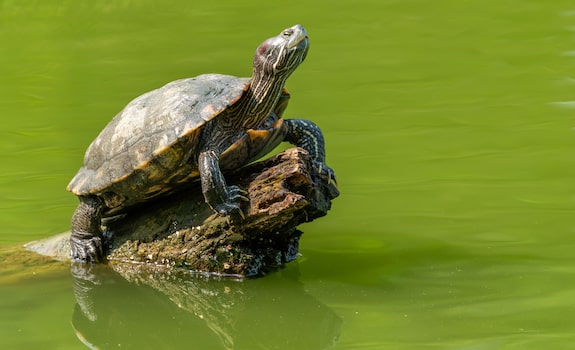
Since red-eared sliders are aquatic and spend most of their time in the water, you DON’T need to worry about the air’s humidity level.
When sliders pull out of the water onto their basking spot, their shell MUST be able to dry entirely underneath the basking light.
Decor and Accessories
Two critical things must be installed in your red-eared slider’s enclosure: a basking spot and a filter.
A basking spot, or haul-out spot, serves many vital purposes for your pet…
Being ectothermic, turtles bask to raise their internal body temperature. This is necessary for healthy digestion and metabolism. They also use their haul-out spot to allow their skin and shell to dry out completely, which is required to prevent algae and shell rot.
The basking spot should be situated directly underneath the UVB light fixture. It should start at the water line so that your turtle can crawl onto it. There are many commercially available options. You can also get creative with driftwood, rocks, floating bark, and even plastic objects like PVC pipes and egg crates.
Red-eared sliders are VERY messy creatures, and they will get sick if their water stays dirty. Because of this, a strong filtration system is VITALLY important.
Most aquarium filters offer chemical filtration, mechanical filtration, and biological filtration. Turtle keepers seem to prefer canister filters for their superior filtration ability.
Hang-on-back filters, otherwise known as waterfall filters, are also an acceptable choice.
The chemical media inside your filter, usually activated carbon, should be changed every three to four weeks.
All areas of the filter except the biological media should be cleaned every month. The biological media should be disturbed as little as possible because that is where the water-cleansing bacteria live.
You should also do a 25% water change every week to every three weeks, with an aquarium water conditioner to neutralize chlorine and other chemicals. This is all VERY similar to the maintenance of aquariums that fish live in.
Your red-eared slider will also appreciate the addition of artificial plants, caves, river stones, and driftwood to explore. These accessories will offer welcomed hiding and enrichment opportunities for your turtle.
🔑 Red-Eared Slider Habitat & Tank Setup Key Takeaways: As the MOST expensive component of turtle ownership, it is crucial you get the enclosure set up on point, offering (at minimum) 10 gallons of water per inch of your turtle’s total length (rounding up), a basking light & spot, and a filtration system. Your turtle will also appreciate accessories such as fake plants and caves, as well as regular water changes to maintain water cleanliness. In terms of tank materials, you’ll have your pick between many materials. Lastly, no substrate is best, but you can also opt for sand and river rock, but NEVER gravel.
Red-Eared Slider Turtle General Health Information
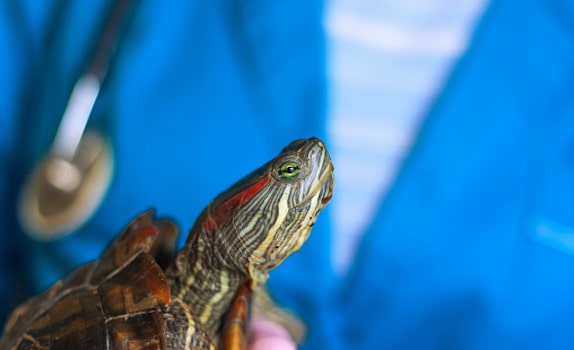
Due to their habitat requirements, red-eared sliders can be prone to several ailments requiring veterinary treatment.
Reptiles are experts at hiding illness, so you should take action as soon as you notice any symptoms. Diseases can progress rapidly.
As always, temperature affects reptilian immune systems significantly, as witnessed by scientific studies. In addition to diet and tank cleanliness, maintaining proper temperature can go a long ways in keeping your pet turtle healthy.
Below are some of the MOST common health issues these turtles (and their owners!) can suffer from…
Salmonella
Most amphibians and reptiles act as symptomless carriers of Salmonella bacteria. This usually won’t cause any issues for your red-eared slider.
Still, it results in gastrointestinal upset and even hospitalization in people. Children, the elderly, and immunocompromised people are at the highest risk.
The CDC recommends not owning any reptiles if there are children under five years old at home. There is no way of telling if your turtle carries Salmonella. Thus, you must wash your hands after you feed or handle your slider, or clean its enclosure.
Respiratory Infections
Just like with other reptiles, red-eared sliders are somewhat prone to respiratory infections.
Symptoms of respiratory infections in turtles are:
- Decreased appetite,
- Discharge from the nose
- Discharge from the eyes
- Lethargy
Your slider may even appear to swim sideways if the congestion throws off their sense of balance.
If you suspect your turtle has a respiratory infection, you will need to take them into the vet ASAP.
If the vet determines an infection is at play, they will prescribe antibiotics which should resolve the infection within a week or so.
Shell Rot
Shell rot is caused by a fungal or bacterial infection in your turtle’s shell.
Mild cases start as a light spot on the turtle’s shell; severe cases can cause parts of the shell to break off, and the infection can spread throughout the body (see below).
Severe cases will require a trip to the vet, but mild cases can often times be treated from home with a DIY shell rot treatment.
Shell rot is most often caused by:
- Dirty water
- Injuries to the shell
- Improper husbandry
- Inappropriate or lack of a basking spot.
Treatment by a veterinarian typically consists of topical antiseptics.
If the home treatment isn’t working or the shell rot is getting worse, you’ll risk the condition worsening and transitioning into Septicemic Cutaneous Ulcerative Disease (SCUD) which can be fatal.
Algae
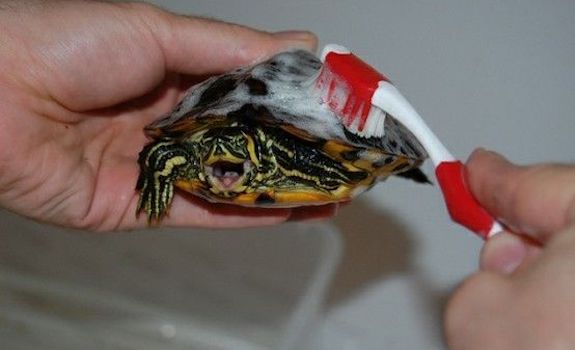
Algae by itself isn’t a significant issue, but it’s a good indication that your red-eared slider isn’t basking and drying out appropriately.
As such, you’ll want to re-evaluate your haul-out spot set up and make any modifications that might help.
If the algae persists, it can conceal injuries on the shell, abscesses, and even shell rot. Once you’ve rectified the basking situation, you can speed up the removal of algae with a soft toothbrush.
Swollen Eyes
This symptom can either be associated with a respiratory infection (discussed above) OR in rare cases, deficiency of Vitamin A.
If you are feeding your turtle a proper diet with pellets, a multivitamin powder, and plant matter, this shouldn’t be an issue. You can accurately suspect a respiratory infection as the culprit.
Shell Injuries
Red-eared sliders are surprisingly prone to scrapes, scratches, cracks, and other injuries on their shell. If the damage is minor, you can rinse it with sterile saline and apply povidone-iodine.
However, keep a close eye on the wound and bring your pet to the veterinarian if it starts to look worse.
Abscesses
Like in humans and other animals, any injury that your red-eared slider suffers CAN become infected and even cause an abscess.
If you notice a sore or lump that DOESN’T start looking better within two to three days, it’s time to take your turtle to a veterinarian for antibiotic treatment and possible draining of the abscess.
🔑 Red-Eared Slider General Health Key Takeaways: Just like any other pet, Red-Eared Slider Turtles can be prone to various health concerns and diseases. Most of the time, a proper tank set up and diet will prevent 99% of the issues listed above. Lastly, owners themselves will want to take heed that turtles, as most reptiles, do carry Salmonella.
Red-Eared Slider Turtle Handling & Bonding
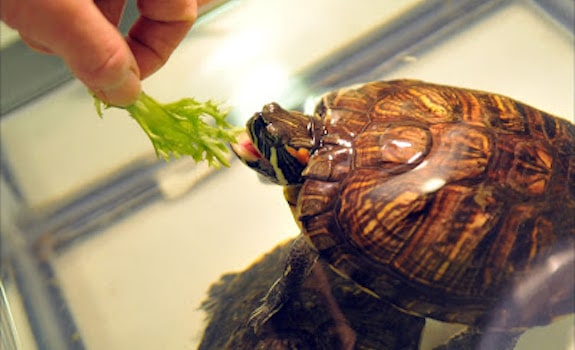
Red-eared sliders will probably be shy for their first few days or weeks at home. You’ll notice this by observing them swimming undercover whenever they see you approach and retracting into their shell if you attempt to handle them.
Your new turtle may even stay retracted in its shell most of the time for several days while it adjusts.
Eventually, once the red-eared slider learns that you are its source of food, it will happily swim up to the surface of the water to greet you and beg for food. It may even follow your finger around on the outside of the glass or acrylic.
Beyond that, aquatic turtles typically don’t appreciate handling. It should be kept to a minimum, for example, if you are inspecting a physical injury, taking it to a veterinarian, or cleaning its enclosure.
A red-eared slider that feels threatened may even nip your fingers! Finally, due to the Salmonella and other germs that they carry, frequently touching your turtle simply ISN’T the best idea.
Instead, you should find other enjoyable ways to interact with your turtle. You can teach them to respond to their name, allow them to sniff new things, hand-feed them, and take photos and videos.
If you want a pet that you can handle very often, you should look into getting a tortoise or another reptile.
🔑 Red-Eared Slider Handling & Bonding Key Takeaways: Also a fascinating pet in their own right, Red-Eared Sliders shouldn’t be handled often due to Salmonella risks and their overall disdain for being held. On top of this, new owners should expect new Red-Eared Sliders to be shy initially. With time, Red-Eared Sliders will warm up to owners, who can find enjoyment in activities such as teaching their pet their name, hand feeding, and introducing new objects to smell!
Is A Red-Eared Slider Turtle Right for YOU?
If you’re on the hunt for an entertaining medium to large sized aquatic turtle and have the budget to create a large and appropriate tank setup, then consider the Red-Eared Slider Turtle a fabulous option for you!
Although shy at first and not an ideal pet for handling, these turtles can provide countless hours of entertainment, are fairly easy to care for, and add real beauty to your home with their striking shell colors and gorgeous tank setups!
However, it can not be stressed enough how CRUCIAL it is to ensure that not only their tank setup but diet is on point. When done right, both of these will prevent health concerns over the years.
For new owners, setting up the tank ahead of time and ensuring all temperatures are where they should be can help tremendously.
With all of this being said, it is my hope that you have found this red-eared slider care sheet to be of assistance in prepping you for a new pet or helping clear up any questions you may have currently about your pet, their enclosure, etc.
